
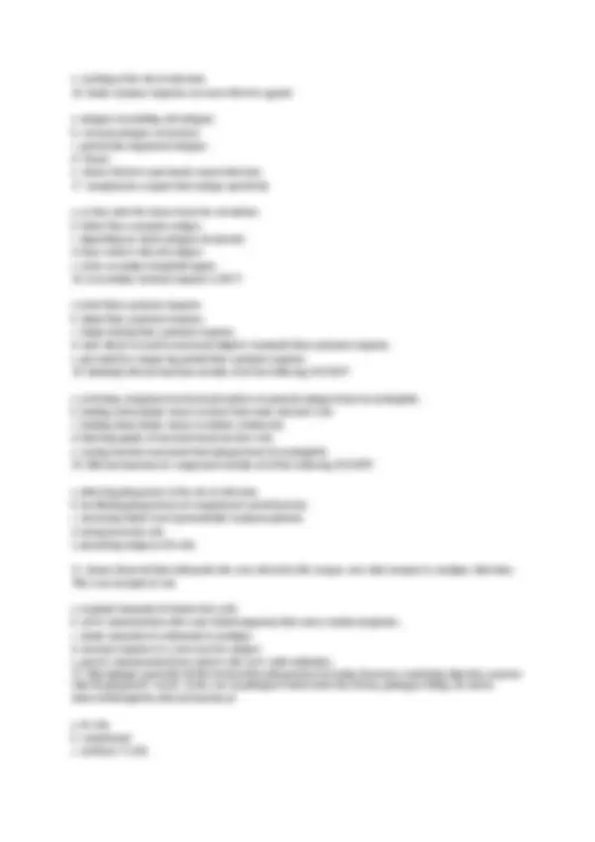
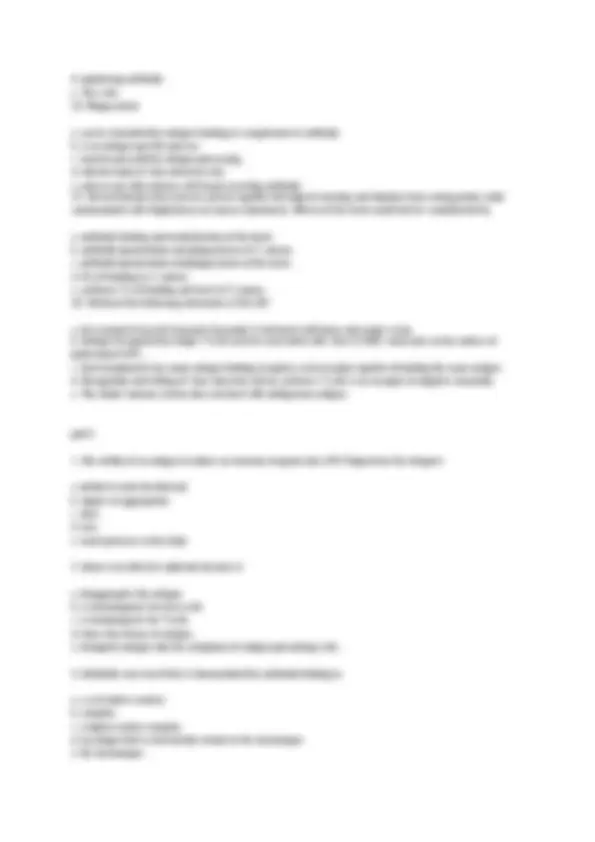
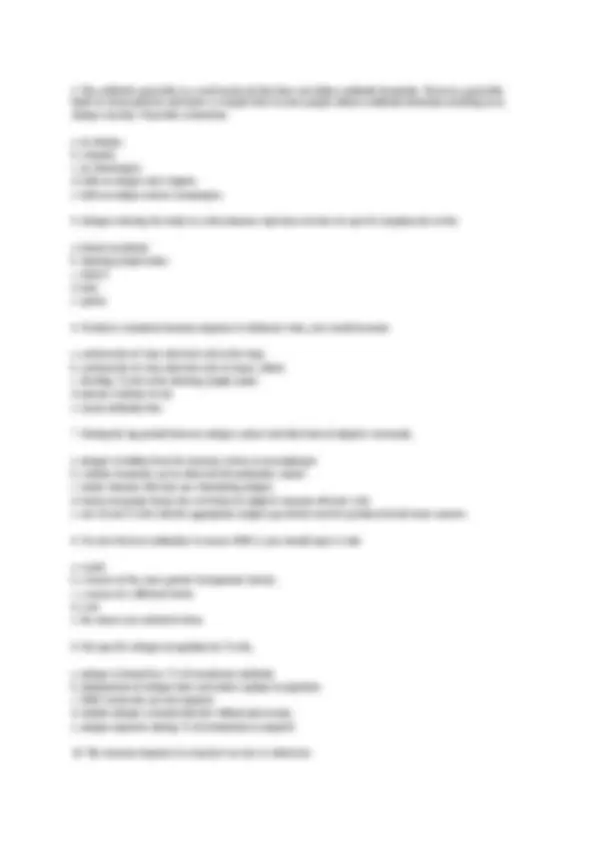
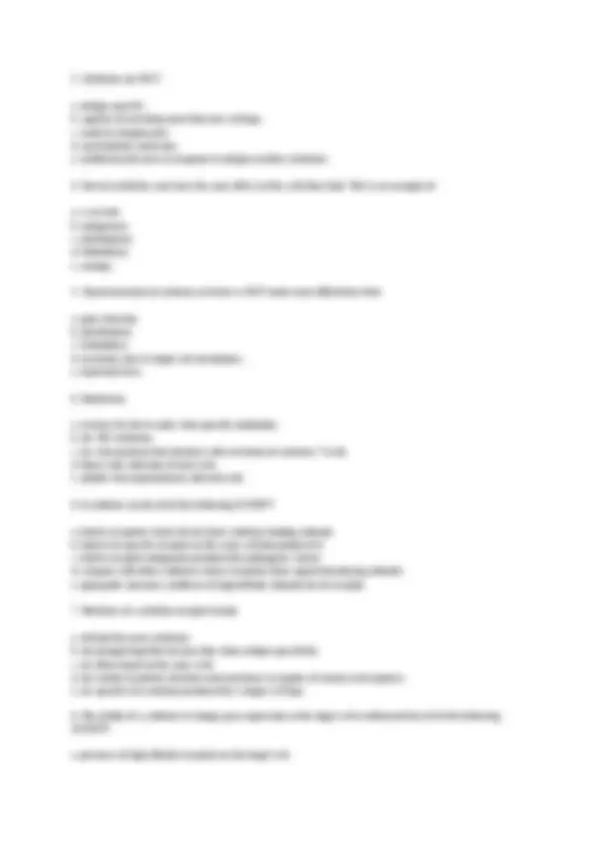
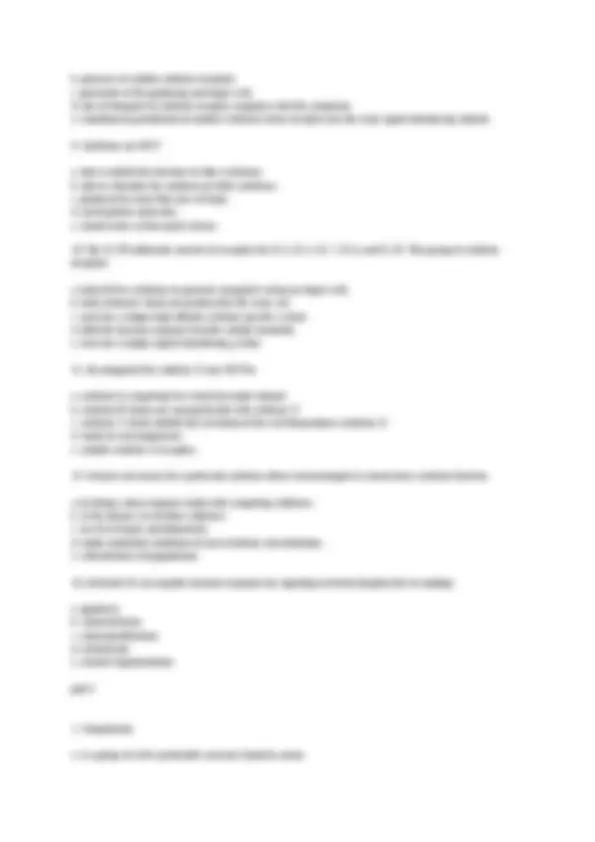
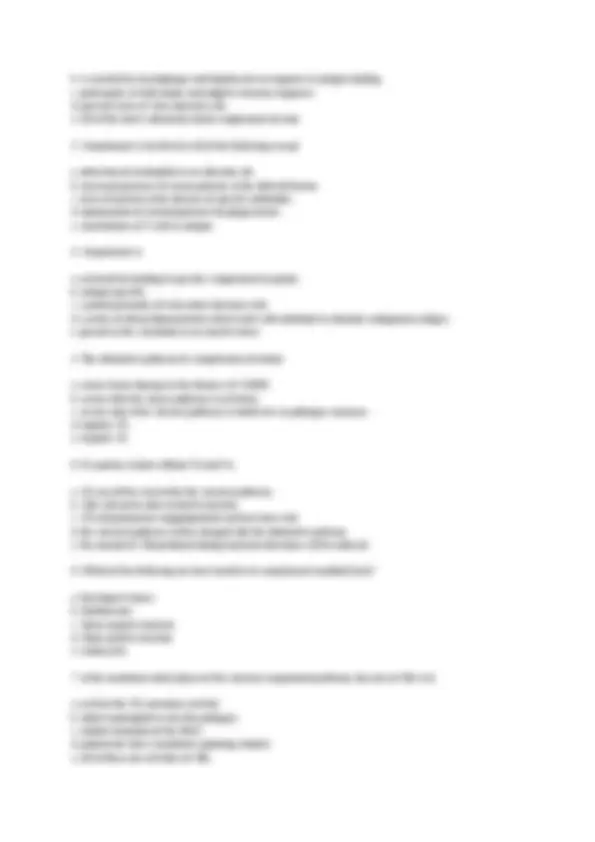
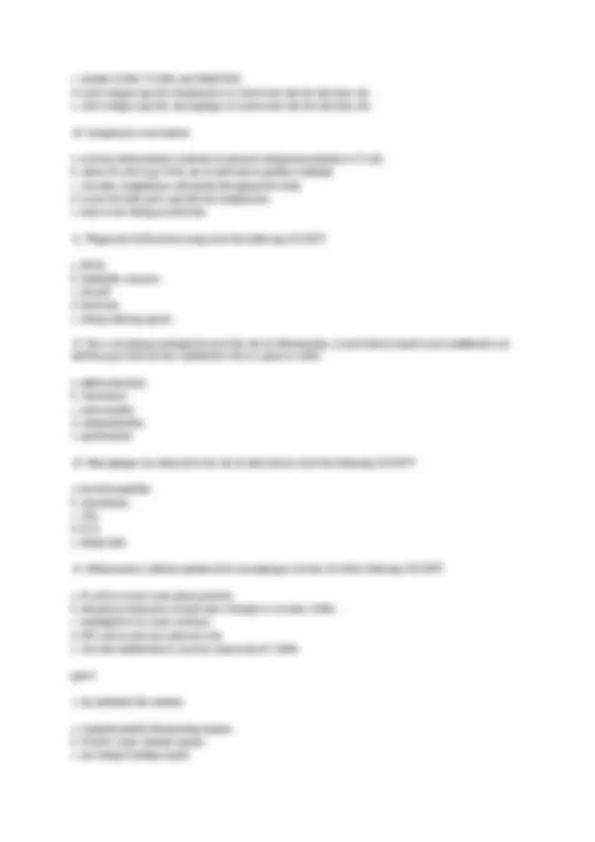
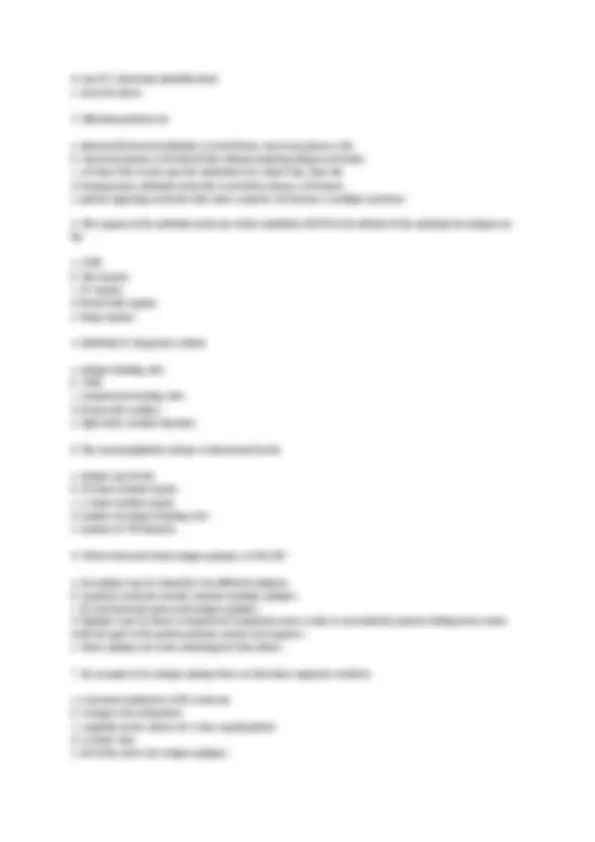
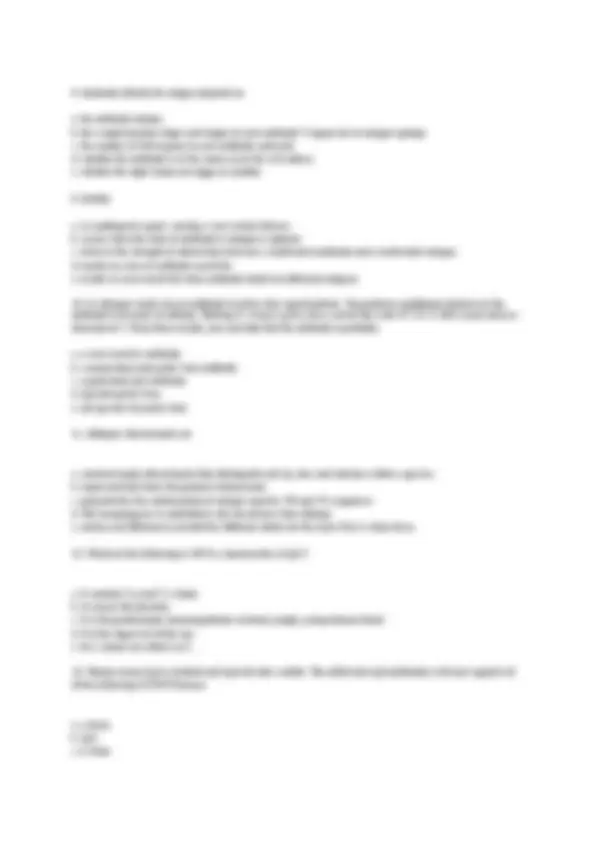
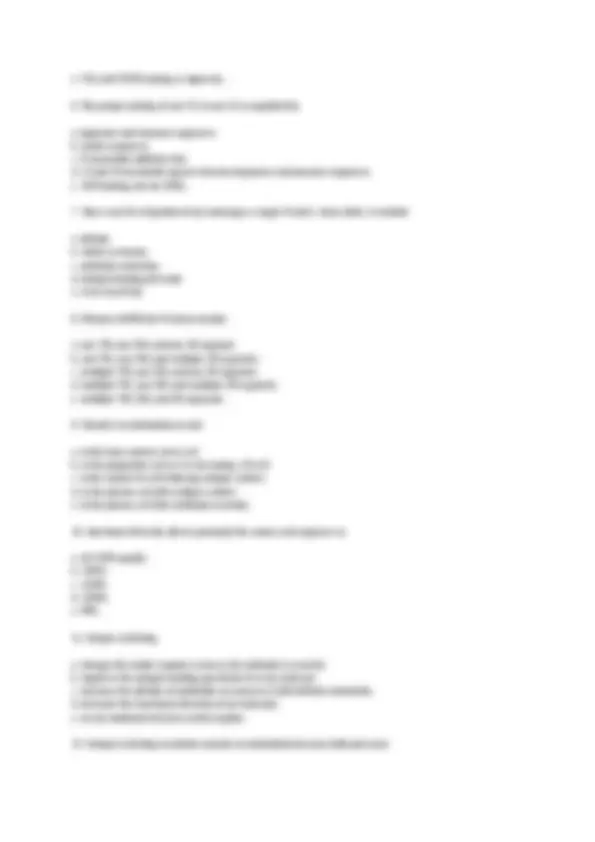
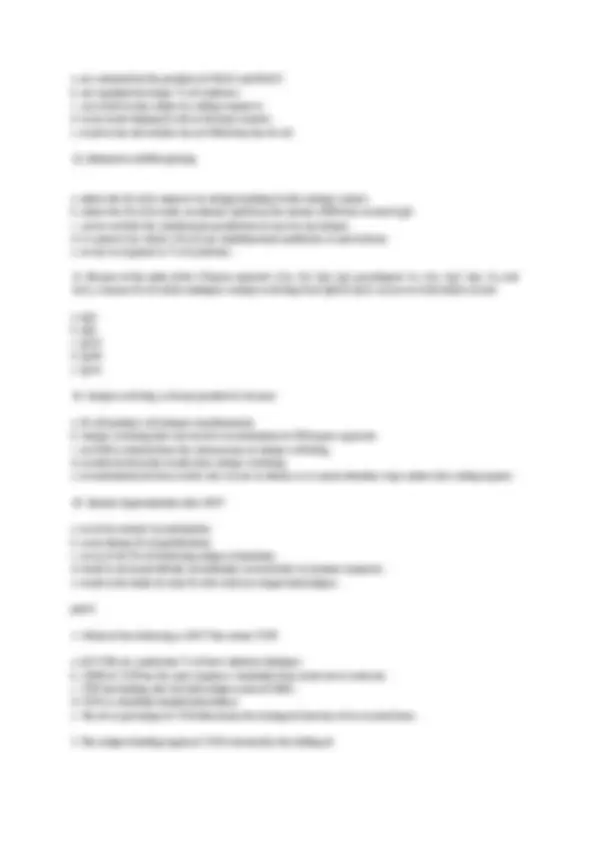
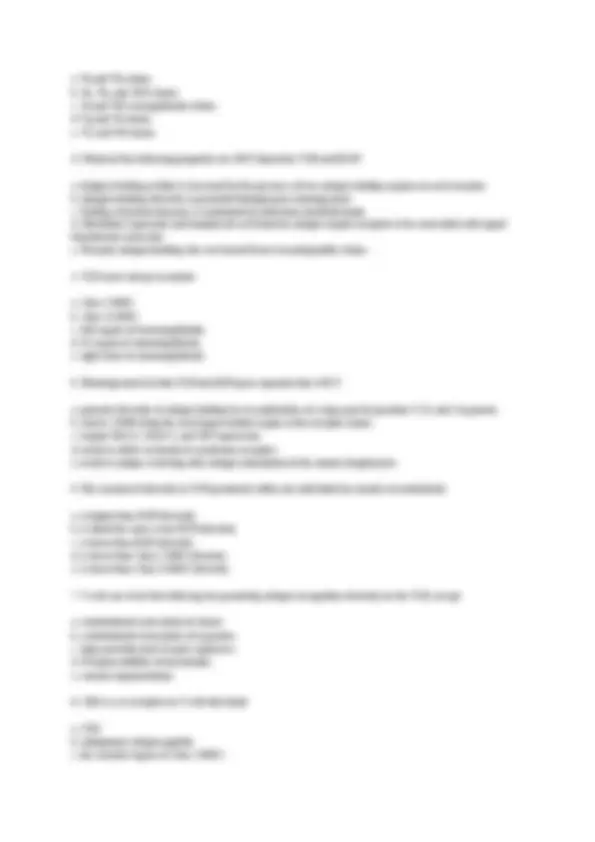
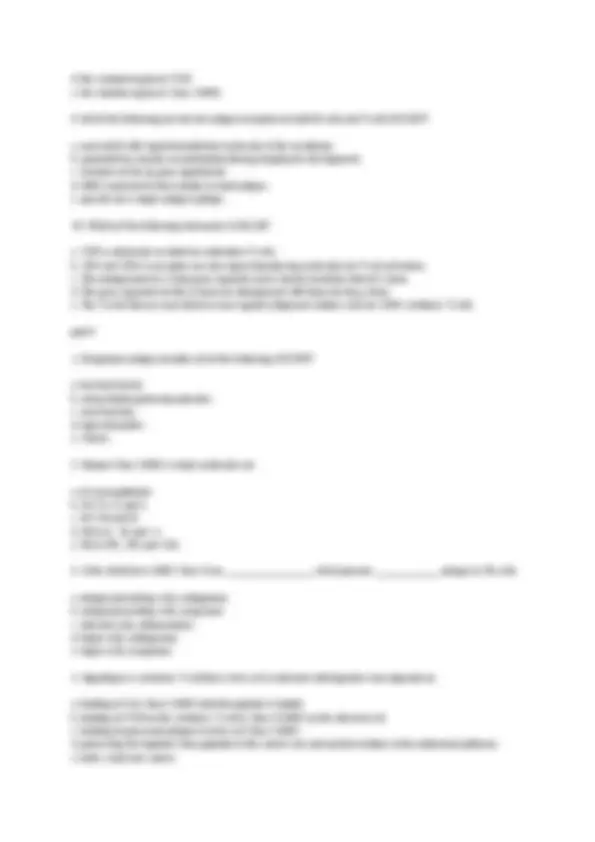
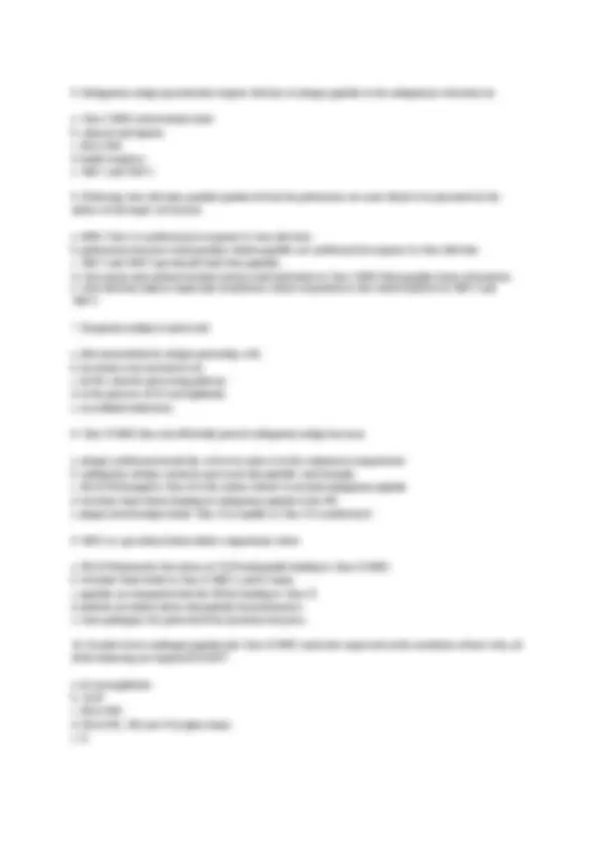
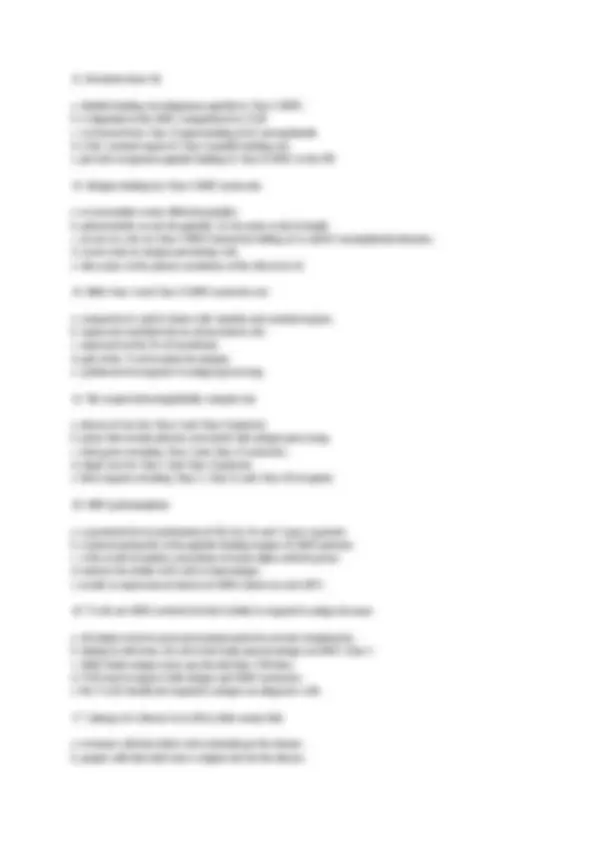
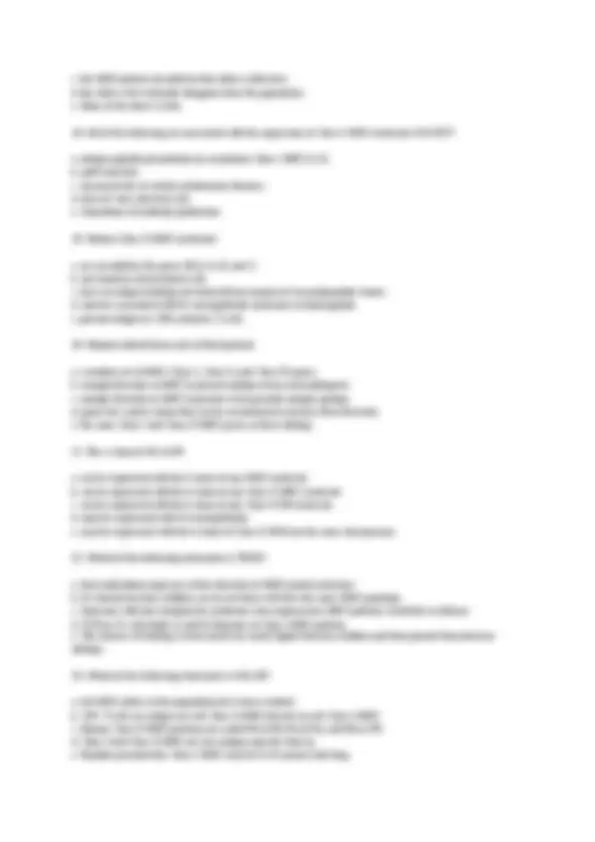
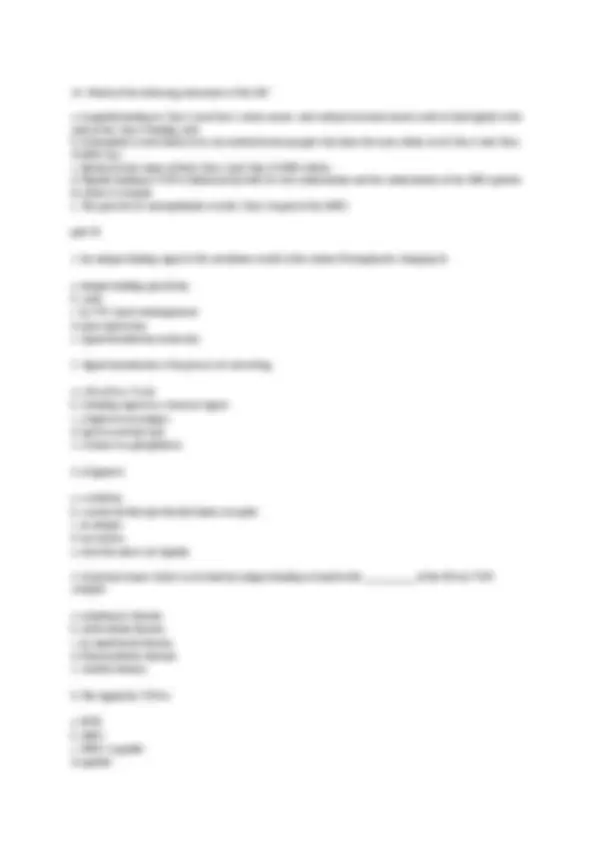
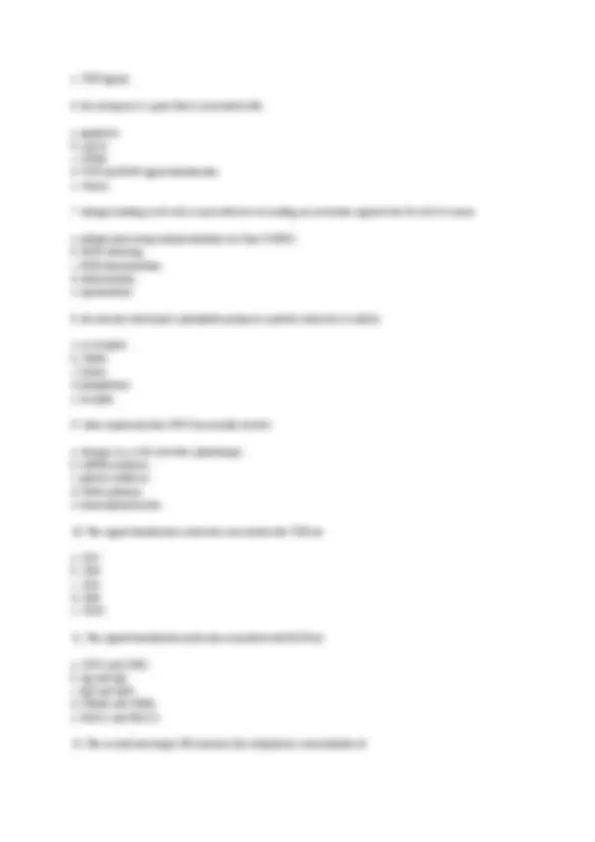
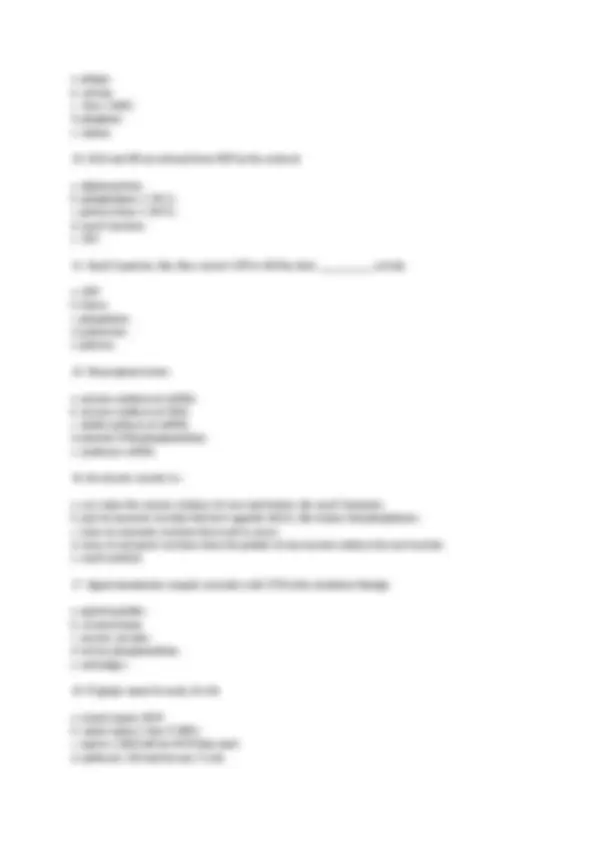
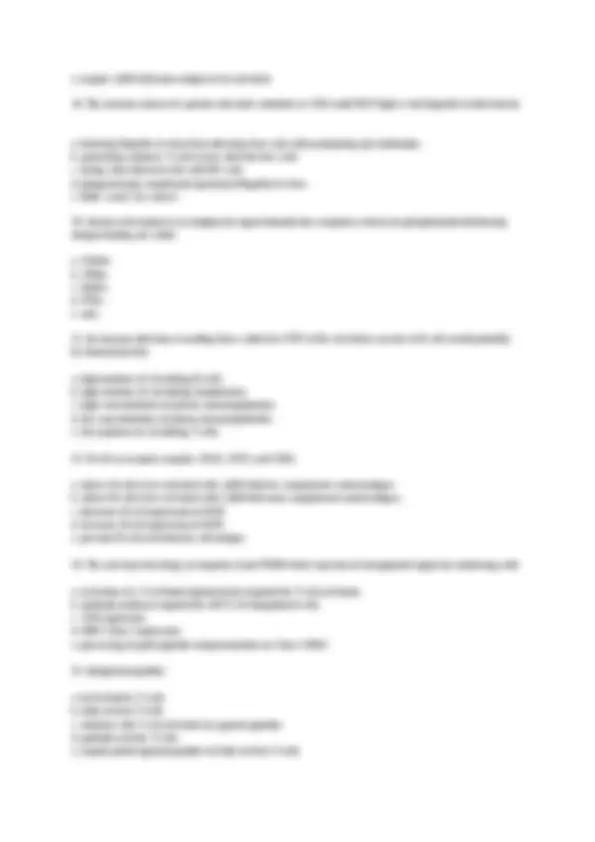
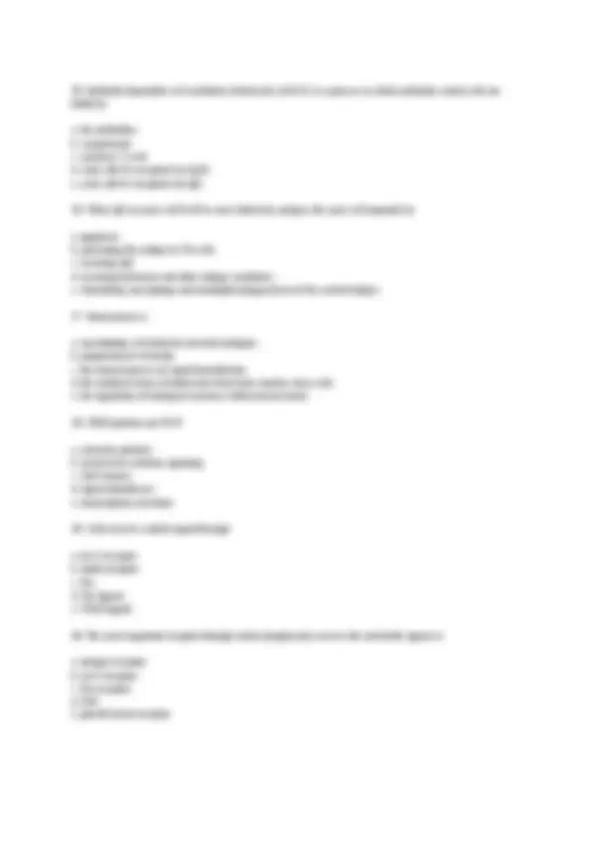


Study with the several resources on Docsity

Earn points by helping other students or get them with a premium plan


Prepare for your exams
Study with the several resources on Docsity

Earn points to download
Earn points by helping other students or get them with a premium plan
Community
Ask the community for help and clear up your study doubts
Discover the best universities in your country according to Docsity users
Free resources
Download our free guides on studying techniques, anxiety management strategies, and thesis advice from Docsity tutors
Examxxxxxxxxxxxxxxxxxxxxxxxxxxxxxxxxxxxxxxxxxxxxxxxxxxxxxxxxxxxxxxxxxxxxxxxxxxxxxxxxxxxxxxxxxxxxxxxxxxxxxxx
Typology: Exams
1 / 29

This page cannot be seen from the preview
Don't miss anything!






















a. are efficient in exposing T cells to foreign antigen. b. are the primary site of antibody synthesis and release. c. filter blood and trap blood-borne antigens. d. provide the microenvironment for maturation of T and B cells. e. line the mucosal surfaces of the body for efficient antigen contact.
a. antigen-specific cells. b. capable of developing into any blood cells. c. committed to produce cells of a single lineage. d. not self-renewing. e. T and B lymphocytes of many different antigen specificities.
a. be killed before they cause autoimmunity. b. efficiently encounter antigen. c. mature from stem cells into lymphocytes. d. phagocytose antigen and kill it. e. go where no cell has gone before.
a. are centrally located in the abdomen to protect their vital functions. b. are designed to maximize contact between antigen and lymphocytes. c. produce antigen-specific lymphocytes from stem cells in response to antigen. d. sequester antigen to minimize its damage to the body. e. store large numbers of activated effector cells for a rapid response to antigen.
a. block all pathogens from entering the body. b. cure allergic reactions. c. kill tumor cells. d. protect from disease upon re-infection with a specific pathogen. e. reject foreign transplants.
a. adaptive immune system. b. innate immune system. c. leukocytes. d. lymphatic system. e. memory response.
a. antigen. b. lymphocytes. c. macrophages. d. PMNs. e. stem cells.
a. antibody production by plasma cells.
b. antigen removal by cilia in the respiratory tract. c. complement activation by antibody bound to the surface of a bacterium. d. memory response to influenza virus e. recognition and killing of virus-infected cells by cytotoxic T cells.
a. activation of antigen-specific lymphocytes. b. folding of antibody to fit the pathogen. c. lysis of only certain pathogens by neutrophils. d. phagocytosis of only certain pathogens by macrophages. e. production of cytokines by antigen-specific macrophages
a. begins with inflammation. b. occurs for all leukocytes. c. occurs in response to self antigens. d. results in innate immunity. e. results in proliferation of antigen-specific lymphocytes.
a. able to induce increased blood vessel permeability. b. antigen-specific. c. made in response to bacterial antigens. d. signals from one cell that affects the behavior of another cell. e. secreted by macrophages.
a. different requirements for antigen presentation. b. function following antigen binding. c. heterogeneity from one lymphocyte to the next. d. heterogeneity on each lymphocyte. e. membrane location.
a. antibody genes are composed of introns and exons. b. DNA for antibody molecules is inherited from only one parent. c. gene segments must be spliced together to make each unique antibody molecule. d. several exons encode each antibody molecule. e. none of the above is true.
a. catching a virus from a friend by shaking hands. b. receiving a vaccine of influenza virus grown in eggs. c. receiving serum from someone who has recovered from an infection. d. receiving leukocytes from an immune family member. e. sharing a soda with someone who has a cold.
a. cytokine production by macrophages. b. migration of leukocytes out of the circulation. c. pain. d. secretion of antibodies.
d. opsonizing antibody. e. Th1 cells.
a. can be stimulated by antigen binding to complement or antibody. b. is an antigen-specific process. c. must be preceded by antigen processing. d. rids the body of virus-infected cells. e. only occurs after plasma cells begin secreting antibody.
a. antibody binding and neutralization of the toxin. b. antibody opsonization and phagocytosis of S. aureus. c. antibody opsonization and phagocytosis of the toxin. d. B cell binding to S. aureus. e. cytotoxic T cell binding and lysis of S. aureus.
a. An example of passive humoral immunity is treatment with horse anti-snake venin. b. Antigen recognized by helper T cells must be associated with Class II MHC molecules on the surface of professional APC. c. Each lymphocyte has many antigen binding receptors, each receptor capable of binding the same antigen. d. Recognition and killing of virus-infected cells by cytotoxic T cells is an example of adaptive immunity. e. The innate immune system does not deal with endogenous antigen.
part-
a. ability to enter the thyroid. b. degree of aggregation. c. dose. d. size. e. usual presence in the body.
a. disaggregates the antigen. b. is immunogenic for stem cells c. is immunogenic for T cells. d. slows the release of antigen. e. transports antigen into the cytoplasm of antigen-presenting cells.
a. a cell surface marker. b. a hapten. c. a hapten-carrier complex. d. an antigen that is structurally similar to the immunogen e. the immunogen.
a. an antigen. b. a hapten. c. an immunogen. d. both an antigen and a hapten. e. both an antigen and an immunogen.
a. blood circulation. b. draining lymph nodes. c. MALT. d. skin. e. spleen.
a. cytotoxicity of virus-infected cells in the lung. b. cytotoxicity of virus-infected cells in tissue culture. c. dividing T cells in the draining lymph nodes. d. plasma cytokine levels. e. serum antibody titer.
a. antigen is hidden from the immune system in macrophages. b. cellular immunity can be detected but antibodies cannot. c. innate immune effectors are eliminating antigen. d. innate immunity blocks the activation of adaptive immune effector cells. e. new B and T cells with the appropriate antigen specificity must be produced in the bone marrow.
a. a goat. b. a mouse of the same genetic background (strain). c. a mouse of a different strain. d. a rat. e. the mouse you isolated it from.
a. antigen is bound by a T cell membrane antibody. b. denaturation of antigen does not reduce epitope recognition. c. MHC molecules are not required. d. soluble antigen is bound directly without processing. e. antigen exposure during T cell maturation is required.
c. foreign MHC. d. live virus. e. virus peptides.
a. An epitope may be shared by two different antigens. b. A protein molecule usually contains multiple epitopes. c. B cells bind only processed antigen epitopes. d. Epitopes may be linear or assembled. e. Some epitopes are more immunogenic than others
a. allow leukocytes to recognize antigen. b. are each expressed on only one cell type. c. are expressed on immune cells by immunologists to "mark" them for separation. d. are found only on leukocytes. e. function as receptors for cytokine and CAMs.
a. CD3. b. CD4. c. CD8. d. CD28. e. CD154.
a. CD21. b. CD56. c. CD80. d. Iga. e. m chain.
part-
a. antagonistic b. autocrine c. endocrine d. paracrine. e. synergistic
a. antigen specific. b. capable of activating more than one cell type. c. made by lymphocytes. d. small protein molecules. e. synthesized de novo in response to antigen or other cytokines.
a. a cascade. b. antagonism. c. pleiotropism. d. redundancy. e. synergy.
a. gene structure. b. pleiotropism. c. redundancy. d. secretion close to target cell membranes. e. short half-lives.
a. activate B cells to make virus-specific antibodies. b. are Th2 cytokines. c. are virus proteins that interfere with activation of cytotoxic T cells. d. block virus infection of host cells. e. inhibit virus replication by infected cells.
a. bind to receptors which do not share cytokine-binding subunits. b. bind to its specific receptor on the same cell that produced it. c. bind to receptor antagonists produced by pathogenic viruses. d. compete with other cytokines whose receptors share signal-transducing subunits e. upregulate (increase) synthesis of high affinity subunits for its receptor.
a. all bind the same cytokines. b. are grouped together because they share antigen specificity c. are often found on the same cells d. are similar in protein structure and sometimes in regions of amino acid sequence. e. are specific for cytokines produced by a single cell type
a. presence of high-affinity receptors on the target cell.
b. is secreted by macrophages and hepatocytes in response to antigen binding. c. participates in both innate and adaptive immune responses. d. prevents lysis of virus-infected cells. e. All of the above statements about complement are true.
a. attraction of neutrophils to an infection site. b. increased presence of serum proteins in the infected tissues. c. lysis of bacteria in the absence of specific antibodies. d. opsonization of microorganisms for phagocytosis. e. sensitization of T cells to antigen
a. activated by binding to specific complement receptors. b. antigen-specific. c. a potent promoter of virus entry into host cells. d. a series of intracellular proteins which work with antibody to eliminate endogenous antigen. e. present in the circulation in an inactive form.
a. causes tissue damage in the absence of C1INH. b. occurs after the classic pathway is activated. c. occurs only if the classical pathway is ineffective in pathogen clearance. d. requires C3. e. requires C4.
a. C5 can still be cleaved by the classical pathway. b. C3b will not be able to bind to bacteria. c. C9 will polymerize inappropriately and lyse host cells. d. the classical pathway will be changed into the alternative pathway. e. the amount of C3b produced during bacterial infections will be reduced.
a. Enveloped viruses b. Erythrocytes c. Gram negative bacteria d. Gram positive bacteria e. Leukocytes
a. activate the C5 convertase activity. b. attract neutrophils to lyse the pathogen. c. initiate formation of the MAC. d. polymerize into a membrane-spanning channel. e. All of these are activities of C5b.
a. activate complement on the surface of pathogens. b. bind only activated complement proteins. c. inhibit complement activation on the surface of host cells. d. on erythrocytes remove immune complexes from the circulation. e. on macrophages signal host cells to make opsonins.
a. a long-lived thioester bond on active complement proteins. b. covalent attachment of all active complement proteins to the pathogen surface. c. plasma proteins that inactivate the anaphylatoxins. d. proteins on host cell membranes that inhibit MAC formation. e. the slow catalytic rates of complement proteases.
a. dissociation of C3 and C5 convertases. b. Gram positive cell walls that are resistant to MAC polymerization. c. host cell plasma proteins that inactivate C3a, C4a, and C5a activity. d. LPS in the outer membrane of Gram negative bacteria that inactivates C3b. e. proteolytic cleavage of complement proteins into smaller fragments.
a. blood in the urine from erythrocyte lysis. b. decreased levels of certain complement proteins in the circulation. c. immune complex disease. d. increased numbers of infections. e. All of the above can result from complement deficiencies.
part-
a. antigen binding to the phagocyte. b. chemotaxis. c. extravasation. d. integrin binding to Ig superfamily CAMs. e. oxidative burst.
a. C5a. b. chemokines. c. glucose. d. LPS. e. selectins.
c. include ICAM, VCAM, and MAdCAM. d. select antigen-specific lymphocytes to extravasate into the infection site. e. select antigen-specific macrophages to extravasate into the infection site.
a. activates inflammatory cytokines to promote antigen presentation to T cells. b. allows B cells to go to the site of infection to produce antibody. c. circulates lymphokines efficiently throughout the body. d. occurs for both naïve and effector lymphocytes e. only occurs during an infection.
a. H2O2. b. hydrolytic enzymes. c. low pH d. lysozyme. e. strong reducing agents.
a. addressinazition. b. chemotaxis. c. extravasation. d. marginalization. e. opsonization.
a. bacterial peptides. b. chemokines. c. C5a. d. IL-8. e. MAdCAM.
a. B cells to secrete acute phase proteins. b. integrin on leukocytes to bind more strongly to vascular CAMs. c. neutrophils to be more cytotoxic. d. NK cells to kill virus-infected cells. e. vascular endothelium to increase expression of CAMs.
part-
a. complementarity determining regions. b. H and L chain variable regions. c. one antigen binding region.
d. one H-L interchain disulfide bond. e. all of the above.
a. abnormally formed antibodies secreted from cancerous plasma cells. b. cancerous plasma cells that divide without requiring antigen activation. c. cell lines that secrete specific antibodies for a short time, then die. d. homogeneous antibody molecules secreted by plasma cell tumors. e. protein signaling molecules that make a plasma cell become a multiple myeloma.
a. CDR. b. Fab regions. c. Fc regions. d. framework regions. e. hinge regions.
a. antigen-binding sites. b. CDR. c. complement-binding sites. d. framework residues. e. light chain variable domains.
a. antigen specificity. b. H chain constant region. c. L chain variable region. d. number of antigen-binding sites. e. number of VH domains.
a. An epitope may be shared by two different antigens. b. A protein molecule usually contains multiple epitopes. c. B cells bind only processed antigen epitopes. d. Epitopes may be linear (composed of sequential amino acids) or assembled by protein folding from amino acids far apart in the protein primary amino acid sequence. e. Some epitopes are more immunogenic than others.
a. a bacterial endotoxin (LPS) molecule. b. a fungal cell wall protein. c. a peptide on the surface of a virus capsid protein. d. a whole virus. e. All of the above are antigen epitopes.
d. l chain. e. secretory component.
a. both k and l chain. b. g chain hinge region. c. J chain. d. g chain allotypic determinants. e. the idiotype of this myeloma.
a. secretory IgA. b. serum IgA. c. serum IgD. d. serum IgG. e. membrane IgM.
a. Increase noncovalent antigen-antibody interactions in the CDR. b. Remove the secretory component. c. Replace the Fc portion of the mu chains with the Fc portion of alpha chains. d. Replace VH and VL framework regions with those from a different antibody. e. Use limited enzyme digestion to make Fab fragments.
a. binds poly-Ig receptor on mucosal epithelial cells. b. has a specialized H chain called secretory chain. c. has a special secretory idiotype. d. is small enough to pass between mucosal epithelial cells and leave the body. e. is synthesized by mucosal epithelial cells and secreted directly into the intestinal lumen.
a. causes allelic exclusion of Ig molecules. b. does not occur against bacterial antigens. c. improves the antigen binding specificity of an Ig molecule. d. increases the effector functions of Ig molecules. e. requires clonal elimination.
a. A cells. b. macrophages. c. mast cells.
d. neutrophils. e. Th1 cells.
a. allotype. b. idiotype. c. isotype. d. IgG. e. g chain.
part-
a. each polypeptide chain is encoded by several exons. b. Ig genes are composed of introns and exons c. somatic recombination occurs before mRNA is transcribed d. there is less Ig genetic material in mature B cells than in other somatic cells e. both c and d are true.
a. one Jk plus one Dk. b. one Jk plus one Ck. c. one Vk plus one Dk. d. one Vk plus one Jk. e. one Vk plus one Jk plus one Dk.
a. intron. b. leader sequence. c. promoter codon. d. signal sequence. e. stop codon.
a. 40. b. 45. c. 70. d. 200. e. 1200.
a. Any L chain can combine with any H chain to form a functional antibody. b. Any Vk can be joined to any Jk to encode the light chain V region. c. Many CH genes are present in the germline DNA. d. Random numbers of N nucleotides can be added during somatic recombination.
a. are catalyzed by the products of RAG1 and RAG b. are regulated by helper T cell cytokines. c. can result in stop codons in coding sequences. d. occur in developing B cells in the bone marrow. e. result in the irreversible loss of DNA from the B cell.
a. allows the B cell to improve its antigen-binding fit after antigen contact. b. allows the B cell to make membrane IgM from the mature mRNA for secreted IgD. c. can be used for the simultaneous production of any two Ig isotypes. d. is a process by which a B cell can simultaneously synthesize m and d chains. e. occurs in response to T cell cytokines.
a. IgA. b. IgE. c. IgG2. d. IgG3. e. IgG4.
a. B cells produce all isotypes simultaneously. b. isotype switching does not involve recombination of DNA gene segments. c. no DNA is deleted from the chromosome in isotype switching. d. no effector diversity results from isotype switching. e. recombination between switch sites occurs in introns so it cannot introduce stop codons into coding regions.
a. occur by somatic recombination. b. occur during B cell proliferation. c. occur in the B cell following antigen stimulation. d. result in increased affinity of antibodies secreted later in immune responses. e. result in the death of some B cells which no longer bind antigen.
part-
a. All TCRs on a particular T cell have identical idiotypes. b. CDR3 of TCR has the most sequence variability from molecule to molecule. c. TCR has binding sites for both antigen and self MHC. d. TCR is a disulfide-bonded heterodimer. e. The ab or gd isotype of TCR determines the biological function of its secreted form.
a. Va and Vb chains. b. Va, Vb, and CD3 chains. c. Va and Vb2-microglobulin chains. d. Vg and Va chains. e. VL and VH chains.
a. Antigen-binding avidity is increased by the presence of two antigen binding regions on each receptor. b. Antigen-binding diversity is generated through gene rearrangement. c. Folding of protein domains is maintained by intrachain disulfide bonds. d. Membrane expression and lymphocyte activation by antigen require receptors to be associated with signal transduction molecules. e. Receptor antigen-binding sites are formed from two polypeptide chains.
a. Class I MHC. b. Class II MHC. c. Fab region of immunoglobulin. d. Fc region of immunoglobulin. e. light chain of immunoglobulin.
a. generate diversity of antigen binding by recombination of a large pool of germline V, D, and J segments. b. lead to CDR3 being the most hypervariable region in the receptor chains. c. require RAG-1, RAG-2, and TdT expression. d. result in allelic exclusion of membrane receptors. e. result in isotype switching after antigen stimulation of the mature lymphocytes.
a. is higher than BCR diversity. b. is about the same as for BCR diversity. c. is lower than BCR diversity. d. is lower than Class I MHC diversity. e. is lower than Class II MHC diversity.
a. combinatorial association of chains. b. combinatorial association of segments. c. large germline pool of gene sequences. d. N region addition of nucleotides. e. somatic hypermutation.
a. CD3. b. endogenous antigen peptide. c. the constant region of Class I MHC.